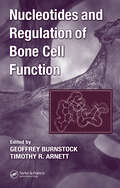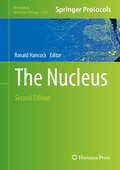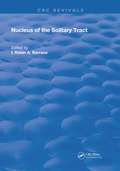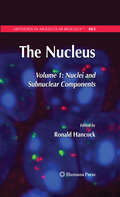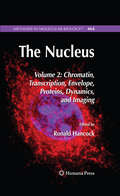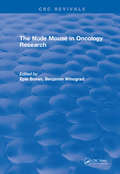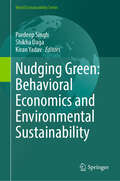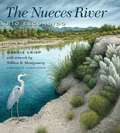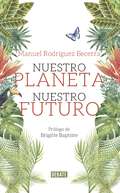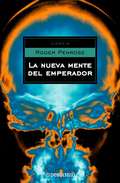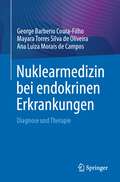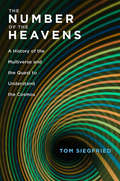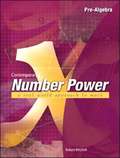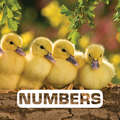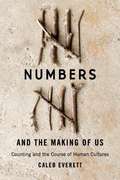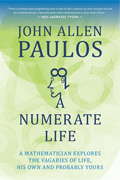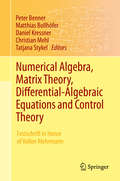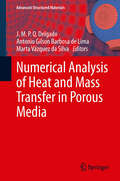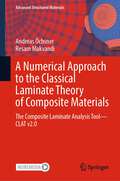- Table View
- List View
Nucleotides and Regulation of Bone Cell Function
by Geoffrey Burnstock Timothy R. ArnettATP's powerful impact on the heart and blood vessels was first described in 1929, but it was not until the 1970s that ATP was proposed as the 'purinergic' neurotransmitter in autonomic nerves. The door to this area of research was thrown open when receptors for ATP and its ectoenzymatic breakdown product adenosine were first cloned in the early 199
The Nucleus: Volume 1: Nuclei And Subnuclear Components (Methods in Molecular Biology #2175)
by Ronald HancockThis detailed new edition delves into recently developed protocols for those working on cell nucleus research, including some of the less well-explored areas of study. Like the previous editions, this book features contributions from top experts in their respective fields. Written for the highly successful Methods in Molecular Biology series, chapters include introductions to their topics, lists of the necessary materials and reagents, step-by-step, readily reproducible laboratory protocols, and tips on troubleshooting and avoiding known pitfalls. Authoritative and up-to-date, The Nucleus, Third Edition will help students and postdocs become aware of vital available methodologies when planning their new projects.
The Nucleus, 2nd Edition
by Ronald HancockThis volume presents detailed, recently-developed protocols ranging from isolation of nuclei to purification of chromatin regions containing single genes, with a particular focus on some less well-explored aspects of the nucleus. The methods described include new strategies for isolation of nuclei, for purification of cell type-specific nuclei from a mixture, and for rapid isolation and fractionation of nucleoli. For gene delivery into and expression in nuclei, a novel gentle approach using gold nanowires is presented. As the concentration and localization of water and ions are crucial for macromolecular interactions in the nucleus, a new approach to measure these parameters by correlative optical and cryo-electron microscopy is described. The Nucleus, Second Edition presents methods and software for high-throughput quantitative analysis of 3D fluorescence microscopy images, for quantification of the formation of amyloid fibrils in the nucleus, and for quantitative analysis of chromosome territory localization. Written in the successful Methods in Molecular Biology series format, chapters include introductions to their respective topics, lists of the necessary materials and reagents, step-by-step, readily reproducible protocols, and notes on troubleshooting and avoiding known pitfalls.<P><P> Authoritative and easily accessible, The Nucleus, Second Edition seeks to serve both professionals and novices with its well-honed methods for the study of the nucleus.
Nucleus of the Solitary Tract (Routledge Revivals)
by I. Robin BarracoFirst Published in 1994, this book provides a comprehensive, up-to-date compilation of reviews of recent literature on the anatomy, physiology, and pharmacology of the nucleus of the solitary tract (NTS). The chapters are written by internationally recognized experts in the field and include never-before-published data, diagrams, and figures.
The Nucleus, Volume 1: Nuclei and Subnuclear Components
by Ronald HancockAlthough our understanding of the structure and activities of the cell nucleus and of the nanomachines which it contains is increasing rapidly, much remains to be learned. The application and continuing development of the new, powerful biochemical and biophysical methodologies described here are essential in this quest. In The Nucleus, researchers from more than forty leading international laboratories describe state-of-the-art methods for isolating nuclei and their components and for studying their structure and activities, including some pathology-associated features. Volume I: Nuclei and Subnuclear Structures presents an overview of features of the intranuclear environment, followed by the most recent procedures for isolating nuclei from a wide range of cell types including muscle cells, yeast, oocytes, cells with polytene nuclei, Arabidopsis, trypanosomes, and dinoflagellates. The latest methods are described for isolating and working with nucleoli, constitutive heterochromatin, pathology-associated inclusions, and chromatin and for examining glycosylation, sumoylation, and ADP-ribosylation of nuclear proteins. Written in the highly successful Methods in Molecular Biology™ series format, chapters contain lists of necessary materials and reagents, readily reproducible protocols, and tips for troubleshooting and avoiding known pitfalls.<P><P> The Nucleus, Volume I: Nuclei and Subnuclear Structures is an essential reference for scientists who are working on our rapidly growing understanding of the cell nucleus and its activities.
The Nucleus, Volume 2: Chromatin, Transcription, Envelope, Proteins, Dynamics, and Imaging
by Ronald HancockAlthough our understanding of the structure and activities of the cell nucleus and of the nanomachines which it contains is increasing rapidly, much remains to be learned. The application and continuing development of the new, powerful biochemical and biophysical methodologies described here are essential in this quest. In The Nucleus, researchers from more than forty leading international laboratories describe state-of-the-art methods for isolating nuclei and their components and for studying their structure and activities, including some pathology-associated features. Volume 2: Chromatin, Transcription, Envelope, Proteins, Dynamics, and Imaging presents biophysical approaches to study the mechanical properties of nuclei, together with a comprehensive range of imaging methods. These include FISH, FRAP, FRET, molecular beacons, fluorescence correlation spectroscopy, single molecule tracking, and combing DNA for optical microscopy, recognition imaging for atomic force microscopy, and hybridisation, tomography, and spectroscopic imaging for electron microscopy. Written in the highly successful Methods in Molecular Biology™ series format, chapters contain lists of necessary materials and reagents, readily reproducible protocols, and tips for troubleshooting and avoiding known pitfalls.<P><P> The Nucleus, Volume 2: Chromatin, Transcription, Envelope, Proteins, Dynamics, and Imaging provides a comprehensive collection of the cutting-edge methods making a major contribution to understanding the nucleus and its nanostructure today.
The Nude Mouse in Oncology Research
by Epie BovenThe nude, athymic mouse (nu/nu) has become generally accepted as a valuable tool to study the biology and therapy of human cancers. This volume presents a critical review of the scientific merits of the animal as a recipient of human tumor tissue transplants. Important information is provided regarding biology, immunology, and measures for genetic and microbiological control of the nude mouse. The discussion of transplantation sites and transplantability of human tumor tissue to the animals includes both the description of host factors and the tumor type involved. The characterization and monitoring of xenografts is followed by a review on their possible application for studies in tumor biology, such as hormones, growth factors, drug resistance, tumor markers, and heterogeneity. Experimental therapy is dedicated to cytostatic agents, hormones, monoclonal antibodies, cytokines, differentiation inducers and radiotherapy. The book also provides critical remarks regarding the limitation of the nude-mouse tumor models. The Nude Mouse in Oncology Research will provide essential reference information for oncology researchers, researchers who work with the nude mouse on a regular basis, and pharmaceutical companies.
Nudging Green: Behavioral Economics and Environmental Sustainability (World Sustainability Series)
by Pardeep Singh Shikha Daga Kiran YadavOur use or rather overuse of natural resources is having an increasingly drastic and adverse effect on the environment. Behavioural economics uses the concepts and elements of psychology and applies them in economic decision-making. It has been identified that behavioural economics can be used to tackle the issue of climate change by using ‘nudges’ to influence people to make choices that are more eco-friendly. Behavioural economics also accept the presence of cognitive biases in the decision-making process, and one solution to reduce the biases is instigating ‘nudges’ that increase the probability of making optimal decisions. The book therefore provides an in-depth understanding of the environmental and climatic issues and the role played by people’s psychology in addressing them. The book highlights cognitive biases and nudges that can be used to negate or reduce the negative impact of decision-making on the environment. The book provides a detailed explanation of the topic along with illustrations, tables, and case studies that make it easy to understand and apply the concepts. The methods, results, and topics covered in the book will be of particular interest to readers interested in behavioural economics, sustainable development, environmental conservation, and various biases that impact decision-making and the nudges that are used and can be used to bring environment protection. The main benefit that readers will derive from the book is a comprehensive understanding of behaviour, biases and nudge-based solutions and their potential to address major challenges faced while making decisions. The book is helpful for policymakers, researchers, practitioners, and students interested in behavioural economics, biases, sustainable development, and environmental protection.
The Nueces River: Río Escondido (River Books)
by Margie CrispFirst appearing on early Spanish maps as the Río Escondido, or hidden river, and later named Río de las Nueces after the abundant pecan trees along its banks, the Nueces today is a stream of seeming contradictions: a river that runs above and below ground; a geographic reminder of a history both noble and egregious; and a spring-fed stream transformed into a salty, steep-sided channel. <P><P>From its fresh, clear headwaters on the Edwards Plateau, Margie Crisp and William B. Montgomery follow the river through the mesquite and prickly pear of the South Texas Plains, to the river’s end in Nueces and Corpus Christi Bays on the Gulf of Mexico. With vivid prose and paintings, they record their travels as they explore the length of the river on foot, kayak, and fishing boat, ultimately weaving a vivid portrait of today’s Nueces. Capturing the river’s subtle beauty, abundant wildlife, diverse culture, and unique history of exploration, conflict, and settlement, they reveal the untold story of this enigmatic river with passion, humor, and reverence.
Nuestro planeta, nuestro futuro
by Manuel Rodríguez BecerraUn panorama global para comprender el fenómeno del cambio climático, apreciar el planeta en el que vivimos y proteger los recursos naturales. Estamos atravesando una profunda crisis ambiental con el cambio climático y el declive de la biodiversidad como sus más graves expresiones. La estamos viviendo en las intensas temporadas de sequía y de lluvia, la agudización de los huracanes, el derretimiento de los glaciares y la acelerada extinción de especies. Millones de personas mueren anualmente por la contaminación del aire y del agua. Todo esto lleva a pensar: ¿cuál es el panorama global? ¿Cuál ha sido el papel de Colombia en crear esta situación y cómo la afecta? ¿Qué tanto incide en las decisiones que tomamos en nuestra vida diaria? Gracias a una aguda y minuciosa reflexión de Manuel Rodríguez Becerra, una de las voces ambientalistas más destacadas del panorama actual, es posible entender los alcances de esta crisis y cómo llegamos a ella, pero también podemos descubrir cómo enfrentarla y el rol que en ese desafío juegan los individuos, las comunidades, los empresarios y los gobiernos. Se trata de una lucha que es de todos y que compromete nuestro presente, nuestro futuro y el de las generaciones venideras.
La nueva mente del emperador: En Torno A La Cibernética, La Mente Y Las Leyes De La Física (Ciencia Y Tecnología Ser.)
by Roger PenroseUn apasionante paseo por la matemática y la física, y por los hallazgos del pensamiento humano. Durante décadas, los defensores de la inteligencia artificial han mantenido que los ordenadores harán pronto todo lo que la mente humana puede hacer. En su favor, se puede utilizar, por ejemplo, el que ya hay máquinas que juegan al ajedrez como los grandes maestros. Ahora bien, ¿comprenden el juego como lo hacemos nosotros? En este libro, Roger Penrose, probablemente el especialista en la teoría general de la relatividad más prestigioso del mundo y una de las mentes analíticas más originales de la actualidad, sostiene que existen facetas del pensamiento humano que nunca serán emuladas por un ordenador. Para defender esa tesis, Penrose recurre a una amplia gama de conocimientos científicos, que van desde la máquina de Turing hasta la estructura del cerebro, pasando por el teorema de Gödel, los agujeros negros y los blancos, la radiación de Hawking, la entropía o la mecánica cuántica. Entre los numerosos estudios existentes dedicados a la relación entre la mente y el cuerpo, esta ambiciosa obra sobresale tanto por su lucidez y claridad como por su rigor y profundidad. Reseña:«Un libro audaz, brillante e innovador. Cuando Penrose habla, los científicos escuchan.»The New York Times Book Review
Nuklearmedizin bei endokrinen Erkrankungen: Diagnose und Therapie
by George Barberio Coura-Filho Mayara Torres Silva de Oliveira Ana Luiza Morais de CamposDieses Buch enthält aktuelle Informationen über die allgemeinen Grundsätze der diagnostischen und therapeutischen Nuklearmedizin im Kontext der Endokrinologie.Der Inhalt ist in sechs Teile gegliedert. In Abschnitt I werden allgemeine Aspekte der Radiopharmaka, der Szintigraphie, der Single-Photon-Emissions-Computertomographie (SPECT), der Positronen-Emissions-Tomographie (PET), der Radionuklidtherapien und der strahlengesteuerten Chirurgie behandelt. Abschnitt II befasst sich mit diagnostischen Anwendungen bei gutartigen Schilddrüsenerkrankungen und der Beurteilung von Schilddrüsenknoten. Abschnitt III gibt einen Überblick über die Behandlung von Nebenschilddrüsenerkrankungen. In Abschnitt IV werden diagnostische Verfahren bei gut differenziertem Schilddrüsenkrebs vorgestellt. Abschnitt V befasst sich mit Verfahren und Therapie bei gut- und bösartigen Erkrankungen der Nebenniere (Phäochromozytome und Paragangliome). Schließlich werden in Abschnitt VI die Diagnose und Behandlung neuroendokriner Tumoren vorgestellt.Nuklearmedizin bei endokrinen Erkrankungen: Diagnose und Therapie richtet sich an nicht spezialisierte Nuklearmediziner, die auf dem Gebiet der Endokrinologie arbeiten, und ist auch für Forscher und Studenten eine wertvolle Ressource.
Nulling Interferometers for Space-based High-Contrast Visible Imaging and Measurement of Exoplanetary Environments
by Brian HicksHigh-contrast astronomical imaging has progressed significantly in the past decade. Many of these techniques have been laboratory demonstrated to perform at contrast levels adequate for the detection of Solar System-like planets and dust around nearby stars. None of them, however, have been demonstrated in space. The state of the art in high-contrast imaging systems that have been built for space-based observation, the environment best suited for spectroscopic study of exo-Earths, is the nulling interferometer that was flown on the Planetary Imaging Concept Testbed Using a Rocket Experiment (PICTURE). The PICTURE nulling interferometer, built from multiple optical elements, relies on the incorporation of additional dispersive components in order to deliver the broadband performance preferred for faint object imaging. These elements add to the cost, complexity, and misalignment risk of the instrument. The Monolithic Achromatic Nulling Interference Coronagraph (MANIC) Brian Hicks describe in this thesis the first optic of its kind. He has taken the multiple optical element concept described in earlier works from theory to a flyable monolithic optic. Brian has advanced the state of the art in nulling interferometers by improving optical stability and robustness. Following application of the fabrication method described in this work, the design of MANIC also allows for broader band performance at higher contrast than that achieved with the PICTURE nulling interferometer.
The Number of the Heavens: A History of the Multiverse and the Quest to Understand the Cosmos
by Tom SiegfriedOne of the most controversial, cutting-edge ideas in cosmology—the possibility that there exist multiple parallel universes—in fact has a long history. Tom Siegfried reminds us that the size and number of the heavens have been contested since ancient times. His story offers deep lessons about the nature of science and the quest for understanding.
Number Power 10: Pre-Algebra
by Robert MitchellNumber Power Series (Revised) The first choice for those who want to develop and improve their math skills. Every Number Power book targets a particular set of math skills with straightforward explanations, easy-to-follow, step-by-step instruction, real-life examples, and extensive reinforcement exercises. Use these texts across the full scope of the basic math curriculum, from whole numbers to pre-algebra and geometry. NUMBER POWER: PRE-ALGEBRA NEW! From basic number skills to data analysis and probability and on to beginning algebra, this book covers material necessary to pass many educational and occupational tests.
Numbers (Picture This)
by Judith NouvionNumbers are everywhere in nature. From one tiny red-eyed frog to ten sweet and scruffy dogs, children will practice counting to ten all while finding out some fun facts about animals in our natural world. Vibrant photography and simple, fun read-aloud text make this board book a perfect first look at nonfiction for very new and curious learners! The Picture This series pairs learning concepts with extraordinary photographs of animals in their habitats. Check out all four books in the Picture This series: Colors, Homes, Numbers, and Shapes!
Numbers and the Making of Us: Counting and the Course of Human Cultures
by Caleb EverettNumber concepts are a human invention developed and refined over millennia. They allow us to grasp quantities precisely: recent research shows that most specific quantities are not perceived in the absence of a number system. Numbers are not innate or universal; yet without them, the world as we know it would not exist.
Numbers Don't Lie: 71 Stories to Help Us Understand the Modern World
by Vaclav Smil"There is no author whose books I look forward to more than Vaclav Smil."--Bill GatesAn essential guide to understanding how numbers reveal the true state of our world--exploring a wide range of topics including energy, the environment, technology, transportation, and food production.Vaclav Smil's mission is to make facts matter. An environmental scientist, policy analyst, and a hugely prolific author, he is Bill Gates' go-to guy for making sense of our world. In Numbers Don't Lie, Smil answers questions such as: What's worse for the environment--your car or your phone? How much do the world's cows weigh (and what does it matter)? And what makes people happy? From data about our societies and populations, through measures of the fuels and foods that energize them, to the impact of transportation and inventions of our modern world--and how all of this affects the planet itself--in Numbers Don't Lie, Vaclav Smil takes us on a fact-finding adventure, using surprising statistics and illuminating graphs to challenge conventional thinking. Packed with fascinating information and memorable examples, Numbers Don't Lie reveals how the US is leading a rising worldwide trend in chicken consumption, that vaccination yields the best return on investment, and why electric cars aren't as great as we think (yet). Urgent and essential, with a mix of science, history, and wit--all in bite-sized chapters on a broad range of topics--Numbers Don't Lie inspires readers to interrogate what they take to be true.
A Numerate Life
by John Allen PaulosEmploying intuitive ideas from mathematics, this quirky "meta-memoir" raises questions about our lives that most of us don't think to ask, but arguably should: What part of memory is reliable fact, what part creative embellishment? Which favorite presuppositions are unfounded, which statistically biased? By conjoining two opposing mindsets--the suspension of disbelief required in storytelling and the skepticism inherent in the scientific method--bestselling mathematician John Allen Paulos has created an unusual hybrid, a composite of personal memories and mathematical approaches to re-evaluating them.Entertaining vignettes from Paulos's biography abound--ranging from a bullying math teacher and a fabulous collection of baseball cards to romantic crushes, a grandmother's petty larceny, and his quite unintended role in getting George Bush elected president in 2000. These vignettes serve as springboards to many telling perspectives: simple arithmetic puts life-long habits in a dubious new light; higher dimensional geometry helps us see that we're all rather peculiar; nonlinear dynamics explains the narcissism of small differences cascading into very different siblings; logarithms and exponentials yield insight on why we tend to become bored and jaded as we age; and there are tricks and jokes, probability and coincidences, and much more.For fans of Paulos or newcomers to his work, this witty commentary on his life--and yours--is fascinating reading.From the Trade Paperback edition.
Numerical Algebra, Matrix Theory, Differential-Algebraic Equations and Control Theory
by Peter Benner Matthias Bollhöfer Daniel Kressner Christian Mehl Tatjana StykelThis edited volume highlights the scientific contributions of Volker Mehrmann, a leading expert in the area of numerical (linear) algebra, matrix theory, differential-algebraic equations and control theory. These mathematical research areas are strongly related and often occur in the same real-world applications. The main areas where such applications emerge are computational engineering and sciences, but increasingly also social sciences and economics. This book also reflects some of Volker Mehrmann's major career stages. Starting out working in the areas of numerical linear algebra (his first full professorship at TU Chemnitz was in "Numerical Algebra," hence the title of the book) and matrix theory, Volker Mehrmann has made significant contributions to these areas ever since. The highlights of these are discussed in Parts I and II of the present book. Often the development of new algorithms in numerical linear algebra is motivated by problems in system and control theory. These and his later major work on differential-algebraic equations, to which he together with Peter Kunkel made many groundbreaking contributions, are the topic of the chapters in Part III. Besides providing a scientific discussion of Volker Mehrmann's work and its impact on the development of several areas of applied mathematics, the individual chapters stand on their own as reference works for selected topics in the fields of numerical (linear) algebra, matrix theory, differential-algebraic equations and control theory. "
Numerical Analysis in Electromagnetics: The TLM Method
by Pierre SaguetThe aim of this book is to give a broad overview of the TLM (Transmission Line Matrix) method, which is one of the “time-domain numerical methods”. These methods are reputed for their significant reliance on computer resources. However, they have the advantage of being highly general. The TLM method has acquired a reputation for being a powerful and effective tool by numerous teams and still benefits today from significant theoretical developments. In particular, in recent years, its ability to simulate various situations with excellent precision, including complex materials, has been demonstrated. Application examples are included in the last two chapters of the book, enabling the reader to draw conclusions regarding the performance of the implemented techniques and, at the same time, to validate them. Contents 1. Basis of the TLM Method: the 2D TLM Method. 2. 3D Nodes. 3. Introduction of Discrete Elements and Thin Wires in the TLM Method. 4. The TLM Method in Matrix Form and the Z Transform. Appendix A. Development of Maxwell’s Equations using the Z Transform with a Variable Mesh. Appendix B. Treatment of Plasma using the Z Transform for the TLM Method.
Numerical Analysis of Heat and Mass Transfer in Porous Media
by Antonio Gilson Lima J.M.P.Q. Delgado Marta Vázquez SilvaThe purpose of 'Numerical Analysis of Heat and Mass Transfer in Porous Media' is to provide a collection of recent contributions in the field of computational heat and mass transfer in porous media. The main benefit of the book is that it discusses the majority of the topics related to numerical transport phenomenon in engineering (including state-of-the-art and applications) and presents some of the most important theoretical and computational developments in porous media and transport phenomenon domain, providing a self-contained major reference that is appealing to both the scientists, researchers and the engineers. At the same time, these topics encounter of a variety of scientific and engineering disciplines, such as chemical, civil, agricultural, mechanical engineering, etc. The book is divided in several chapters that intend to be a resume of the current state of knowledge for benefit of professional colleagues.
Numerical and Statistical Methods for Bioengineering
by Michael R. King Nipa A. ModyThe first MATLAB-based numerical methods textbook for bioengineers that uniquely integrates modelling concepts with statistical analysis, while maintaining a focus on enabling the user to report the error or uncertainty in their result. Between traditional numerical method topics of linear modelling concepts, nonlinear root finding, and numerical integration, chapters on hypothesis testing, data regression and probability are interweaved. A unique feature of the book is the inclusion of examples from clinical trials and bioinformatics, which are not found in other numerical methods textbooks for engineers. With a wealth of biomedical engineering examples, case studies on topical biomedical research, and the inclusion of end of chapter problems, this is a perfect core text for a one-semester undergraduate course.
A Numerical Approach to the Classical Laminate Theory of Composite Materials: The Composite Laminate Analysis Tool—CLAT v2.0 (Advanced Structured Materials #189)
by Andreas Öchsner Resam MakvandiThis book first provides a systematic and thorough introduction to the classical laminate theory for composite materials based on the theory for plane elasticity elements and classical (shear-rigid) plate elements. The focus is on unidirectional lamina which can be described based on orthotropic constitutive equations and their composition to layered laminates. In addition to the elastic behavior, failure is investigated based on the maximum stress, maximum strain, Tsai-Hill, and the Tsai-Wu criteria.The solution of the fundamental equations of the classical laminate theory is connected with extensive matrix operations, and many problems require in addition iteration loops. Thus, a classical hand calculation of related problems is extremely time consuming. In order to facilitate the application of the classical laminate theory, we decided to provide a Python-based computational tool, the so-called Composite Laminate Analysis Tool (CLAT) to easily solve some standard questions from the context of fiber-reinforced composites. The tool runs in any standard web browser and offers a user-friendly interface with many post-processing options. The functionality comprises stress and strain analysis of lamina and laminates, derivation of off-axis elastic properties of lamina, and the failure analysis based on different criteria.
